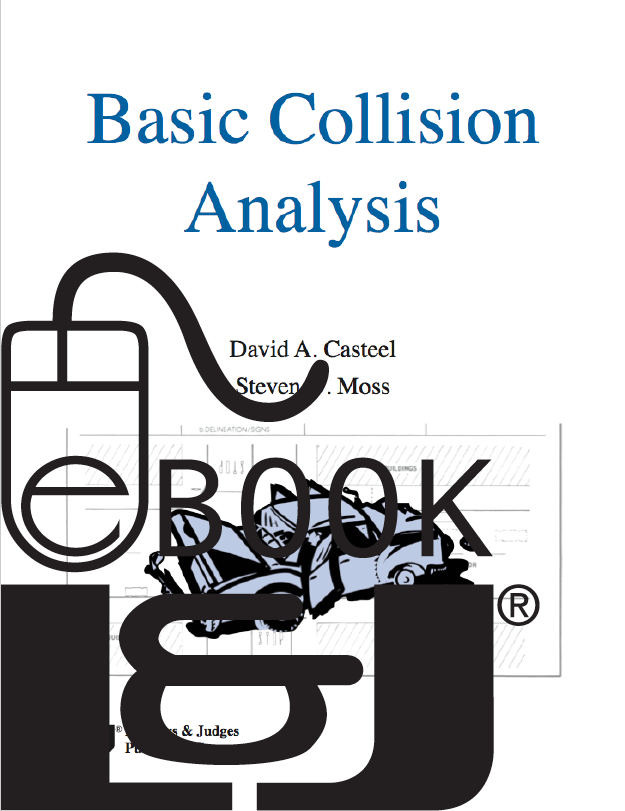
Basic Collision Analysis PDF eBook
- Author: David A. Casteel, Steven D. Moss
- ISBN 10: 0-913875-82-1
- ISBN 13: 978-0-913875-82-7
- Copyright Date Ed: October 8, 1999
- Pages: 208 pages
- PDF eBook
Point of possible perception? Point of actual perception? Point of response? Skid tire, scuff tire, metal marks or all three? Weather? Lighting? Trees and shrubs? Parked vehicles, fences, buildings, or other obstructions? Investigating any accident scene is no doubt a complex task. Determining the accurate answers to these questions from participants, and from non-participants as well, can be even harder. With this book, you will not have to spend fruitless hours re-creating the accident over and over again because of lack of notes, inadequate interviews, or blurry photographs. Instead, you will have everything organized from the start in a clear, cohesive story--fully documented with all the witness statements, notes, photographs, and reports ever needed. Discover how you can use this valuable guide to save time without sacrificing accuracy; it is, simply, the only book you will ever need to fully report any automobile accident scene.
Table of Contents
Chapter 1: Basic Collision Investigation1.1 Introduction
1.2 Strategy
1.3 Collision Scene
A. Geometric configuration
B. Surface material
C. Delineators
1. Raised pavement markers (R.P.M.)
2. Painted markers
3. Contrasting shoulders
4. Raised center medians
5. Post delineators
1.4 Evidence/Roadway Markings
A. Final rest positions of all vehicles and bodies involved in the collision
B. Tire marks
1. Skid marks
2. Scuff marks
3. Tire prints
C. Metal marks
D. Collision debris
E. Pedestrian manifestations
1.5 Documentation and Measurements
A. Coordinate method
B. Triangulation method
1.6 Special Measuring Problems
A. Large areas of debris
B. Pedestrian's final rest position
C. Locating gouge mark
D. Skid marks
E. Inertial scuff marks
1.7 Diagramming
1.8 Vehicle Examination and Documentation
A. Vehicle identification
B. Precollision vehicle factors
C. Vehicle defects
D. Vehicle load
E. Collision scene examination
F. Vehicle examination at the secondary site
1. Identification of the driver
2. Mechanical condition
3. Documentation of vehicle damage
1.9 Post-Collision Examination of Vehicle Lamps
J. A. "Jack" Foultz, Chief Instructor San Diego Transit
A. Introduction
B. Undamaged lamps
C. Lamps involved in a collision
1. No visible damage
2. Cold fracture
3. Filament deformation
4. Hot break
5. Effect of post-collision fire
1.10 Morgue Scene
Chapter 2: Kinematics--A Description of Motion
2.1 Introduction
2.2 Velocity While Accelerating to or from a Stop
2.3 Combined Velocities
2.4 Uniform Circular Motion
2.5 Kinematic Relationships
A. Constant velocity
B. Time to accelerate to or from a stop
C. Time during a velocity change
D. Distance traveled during acceleration (±)
E. Velocity at any point during acceleration (±)
F. Time/distance problems
G. Vehicle versus pedestrian
2.6 Commentary
Chapter 3: Projectile Motion
Chapter 4: Effective Drag Factor and Frictional Force
4.1 Introduction
4.2 Friction
4.3 Test Skids
A. Equipment
B. The test
Chapter 5: Vehicle Dynamics
5.1 Introduction
5.2 The Impact
5.3 Conservation of Momentum
5.4 Keys to Basic Momentum Analysis
Chapter 6: Motorcycles
Paul Geis
6.1 Investigating and Recording Motorcycle Collisions
6.2 The Motorcycle, a Unique Vehicle
6.3 Professional Biases Re: Motorcycles
6.4 Attention to Detail
6.5 Motorcycle Types--The Similarities and Differences
A. The transportation bike
B. The touring bike
C. The canyon racer or cafe bike
D. The on/off-road bike
E. The off-road or motocross bike
F. The chopper--severely altered
6.6 An Analysis of the Collision-Involved Motorcycle Rider
A. Ages
B. Experience
C. Skill level
D. Typical errors in collision avoidance
E. Frequency of injury
F. Use of protective clothing
6.7 An Analysis of the Collision-Involved Automobile Driver
A. Ages
B. Ability to recognize the motorcyclist
C. Most common statement made
6.8 Preventative Measure Methodology
A. Education
1. Motorcyclist
2. Auto driver
3. Citation-related driver education
B. Licensing
1. Written tests
2. Realistic riding evaluation
C. Enforcement
1. The unlicensed rider
2. The rider under the influence of alcohol and/or narcotics
3. Diligent post-crash enforcement of culpable parties
6.9 Conclusion
A. Reevaluation of motorcycle collision investigations
B. Rethinking of motorcycle enforcement policies
Chapter 7: Human Factors
7.1 Introduction
7.2 Psychological and Cultural Factors
A. Cultural factors
B. Emotional/psychological factors
7.3 Physiological Factors
A. The nervous system
B. Senses
7.4 Reaction Time
7.5 Perception Time
7.6 Altered Physiological Factors
A. Physical handicap
B. Alcohol and drugs
C. Fatigue
D. Environment
E. Age
7.7 Witnesses
A. Attention
B. Field of view
C. Education and experience
D. Emotional condition
E. Prejudice
F. Bias
Chapter 8: Field Testing of the Impaired Driver
8.1 Introduction
8.2 The Five-Step Process
8.3 The Field Coordination Test
8.4 Relationship to Driving
8.5 Gaze Nystagmus, Additional Considerations
8.6 What to Expect in Court
8.7 Commentary
Appendix One: Pedestrian-Vehicle Collision Course
Bruce F. Herms, City Traffic Engineer, City of San Diego
Appendix Two: Traffic Investigation Equation Sheet
Appendix Three: Pedestrian vs. Vehicle Time-Distance Study
References
Glossary of Terms
Index
